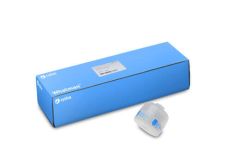Close
BILE ESCULIN AZIDE AGAR (ISO 7899-2) 500 grams/bottle
SKU
CDL/1005
Brand
CONDALAB
Pre-order (Deliver in 8 to 12 weeks)
Bile Esculin Azide Agar is a modification of Bile Esculin Agar (Cat. 1031), with the addition of sodium azide as an inhibitor and with the reduction of the bile concentration. The resulting medium is more selective but still provides rapid growth and efficient recovery of enterococci. The ability to hydrolyze esculin in the presence of bile is a characteristic of enterococci. Organisms positive for esculin hydrolysis hydrolyze the glycoside esculin to esculetin and dextrose. The esculetin reacts with the Ferric amonium citrate to form a dark brown or black colony. Ox bile does not inhibit enterococci while other Gram positive bacteria are inhibited. Sodium azide inhibits Gram negative bacteria. Tryptone, peptone and yeast extract supply the nutrients essential for growth. Sodium chloride provides the osmotic balance. Bacteriological agar is the solidifying agent.
The presence of intestinal enterococci is an indicator for faecal contamination, especially when the contamination occurred a long before and the less resistant coliform bacteria, including Escherichia coli, may already be dead when the analysis is carried out.
Tolerance to bile and the ability to hydrolyze esculin constitutes a reliable presumptive test for the identification of enterococci. Appears a brown color (positive reaction) around the colonies.
Bile Esculin Azide Agar is a modification of Bile Esculin Agar (Cat. 1031), with the addition of sodium azide as an inhibitor and with the reduction of the bile concentration. The resulting medium is more selective but still provides rapid growth and efficient recovery of enterococci. The ability to hydrolyze esculin in the presence of bile is a characteristic of enterococci. Organisms positive for esculin hydrolysis hydrolyze the glycoside esculin to esculetin and dextrose. The esculetin reacts with the Ferric amonium citrate to form a dark brown or black colony. Ox bile does not inhibit enterococci while other Gram positive bacteria are inhibited. Sodium azide inhibits Gram negative bacteria. Tryptone, peptone and yeast extract supply the nutrients essential for growth. Sodium chloride provides the osmotic balance. Bacteriological agar is the solidifying agent.
The presence of intestinal enterococci is an indicator for faecal contamination, especially when the contamination occurred a long before and the less resistant coliform bacteria, including Escherichia coli, may already be dead when the analysis is carried out.
Tolerance to bile and the ability to hydrolyze esculin constitutes a reliable presumptive test for the identification of enterococci. Appears a brown color (positive reaction) around the colonies.
| Brand | CONDALAB |
|---|
Write Your Own Review








Validate your login